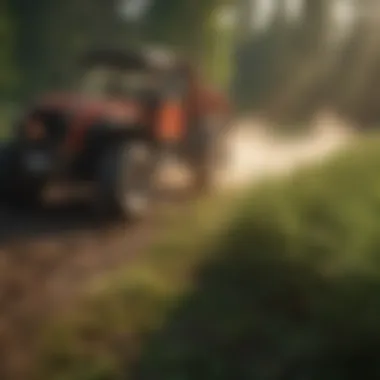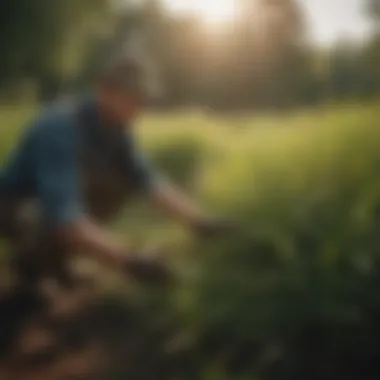Effective Johnson Grass Control Strategies for Farmers


Intro
Johnson grass is a perennial grass species that can behave invasively, causing significant disruptions in agricultural settings and natural ecosystems. Its ability to grow rapidly and spread aggressively presents challenges that landowners, farmers, and environmental stewards must address effectively. To create a comprehensive guide on this topic, it is vital to explore strategies ranging from chemical treatments to integrated weed management practices. Understanding the merits and limitations of these methods will equip agricultural professionals with the knowledge needed for sustainable management of this pervasive weed.
This article outlines essential points related to Johnson grass control and emphasizes the importance of informed practices that not only focus on eradication but also consider the balance of ecosystem health and agricultural productivity.
Understanding Johnson Grass
Understanding Johnson grass is crucial for developing effective management strategies. This perennial grass species has a reputation for its vigorous growth and ability to displace native flora, which can lead to serious ecological ramifications. Gaining a comprehensive understanding of its botanical traits, ecological impact, and economic significance enables landowners and agricultural experts to adopt a more informed approach to control measures. Knowledge about Johnson grass not only aids in recognizing its invasive potential but also underscores the importance of timely interventions to mitigate its spread.
Botanical Characteristics
Johnson grass, scientifically known as Sorghum halepense, is a tall perennial grass that can reach heights of up to 1.5 meters or more. This grass has broad, lanceolate leaves that can be up to 50 centimeters long. Its stems are erect and hollow, which distinguishes it from many other grass species. The plant has a robust root system that allows it to access moisture deep in the soil, giving it a competitive advantage in dry conditions.
A notable feature of Johnson grass is its flowering structure. It produces dense, feathery flower heads, which can be seen from late summer to early fall. The seed production is prolific; a single plant can produce thousands of seeds that can remain dormant in the soil for years. This characteristic makes it a formidable challenger in any ecosystem, particularly in agricultural settings.
Ecological Impact
The ecological ramifications of Johnson grass infestation are significant. As it spreads aggressively, it can outcompete native plant species, leading to reduced biodiversity. This competition often results in habitat loss for various insects and animals that rely on native plants for food and shelter.
Furthermore, Johnson grass can alter soil structure and nutrient cycling. Its deep root system can deplete moisture and nutrients from the soil, making it difficult for other plants to thrive. In agricultural systems, this can lead to decreased crop yields and increased reliance on herbicides, perpetuating a cycle of dependency that is difficult to break.
"Understanding the ecological impact of Johnson grass is essential for developing strategies that protect native biodiversity and maintain ecosystem balance."
Economic Implications
The economic implications of Johnson grass infestations extend significantly beyond simple control costs. It can reduce crop yields by competing for essential resources, leading to lost revenue for farmers. According to various studies, infestations in agricultural fields can result in yield losses of up to 50%. This impact can spiral into broader economic consequences, affecting market prices and local economies reliant on agriculture.
Additionally, the cost of control measures can be considerable. Landowners may face ongoing expenses related to herbicide application, mechanical removal, and other management practices. Investing in effective management strategies can thus offer substantial long-term economic benefits, reducing reliance on chemical control and promoting more sustainable practices.
Identifying Johnson Grass Infestations
Identifying Johnson grass infestations is a crucial step in managing this invasive species effectively. Early detection can significantly mitigate its impact on crops and ecosystems. By understanding the habitat preferences and signs of infestation, landowners and agricultural professionals can adopt timely measures to control this perennial grass.
Habitat Preferences
Johnson grass thrives in a variety of environments. It often prefers disturbed sites, which include agricultural fields, roadsides, and areas with poor soil management. The grass displays a strong inclination towards warm climates; however, it can also adapt to cooler conditions. Its preference for moist soil gives it an advantage in wet seasons, making irrigation zones particularly vulnerable.
Some specific characteristics of the habitat prefer by Johnson grass include:
- Well-drained soils that are rich in nutrients.
- Sunny locations, as the grass requires full sunlight to grow optimally.
- Areas with inadequate competition from other plant species, allowing it to dominate the landscape.
Recognizing these habitat preferences can aid in assessing risk zones and focusing control efforts in the most susceptible areas.
Signs of Infestation
Detecting Johnson grass early can prevent its spread and establishment. Identifying the signs of infestation will help landowners act promptly. Key indicators include:
- Distinctive Leaf Texture: Johnson grass has broad, blade-like leaves, often with a noticeable midrib. The leaves can grow up to two feet long and have a rough texture.
- Growth Habit: The grass can reach heights of four to six feet, with tall stems that may appear bushy when dominant.
- Flowering Stems: Flower spikes, which develop in late summer, can produce seed heads that resemble a corn tassel. The seeds are lightweight, aiding in their dispersion by wind.
- Rhizome Development: Johnson grass spreads rapidly via rhizomes, which are underground stems. Observing patches of dense growth can indicate the presence of these rhizomes.


Monitoring these signs can enable prompt action. Identifying infestations early not only helps in controlling Johnson grass but also minimizes its economic impact on agriculture.
Chemical Control Methods
Chemical control methods are crucial in managing Johnson grass effectively. These strategies focus on the application of herbicides to reduce the growth and spread of this invasive grass. Various factors must be taken into account when considering chemical options, including the specific type of herbicide, timing of application, and dosage. Effective use of these methods can lead to significant reductions in Johnson grass populations, enhancing agricultural productivity and safeguarding ecosystems.
Herbicide Applications
The selection of the right herbicide is a pivotal point in controlling Johnson grass. Non-selective herbicides, such as glyphosate, can provide thorough control but may also harm desirable crops if not applied carefully. Selective options are available and target specific weed species without significantly damaging adjacent crops. Commonly used herbicides include imazapyr and sethoxydim. These substances need to be applied according to manufacturer's instructions to ensure optimal results. Proper calibration of spraying equipment is also necessary to maximize effectiveness while minimizing environmental impact.
- Types of Herbicides
- Glyphosate
- Imazapyr
- Sethoxydim
When applying herbicides, it is important to consider factors like wind speed, temperature, and humidity to avoid unwanted drift and reduce evaporation rates. Using adjuvants can enhance herbicide effectiveness by improving penetration and coverage on plant surfaces.
Timing and Dosage
Timing is a crucial aspect of herbicide application. The ideal window for treating Johnson grass is during its active growth phase, which typically occurs in late spring to early summer. This is when the grass is most vulnerable to herbicide effects. The growth stage affects both the absorption of the herbicide and its overall effectiveness.
- Pre-emergent Herbicides
These should be applied before Johnson grass germination to prevent its establishment. - Post-emergent Treatments
When Johnson grass is established, post-emergent herbicides can be used.
However, dosages must be precise, as both under-application and over-application can result in inadequate control or damage to non-target species. Following label instructions is pivotal.
A structured approach to treatment can often provide the best results. Landowners should scout areas for initial infestations and then determine the best time for treatment based on environmental conditions.
Resistance Management
Managing herbicide resistance is an increasingly significant concern in weed control. Johnson grass has shown the ability to develop resistance to certain herbicides. Therefore, implementing a resistance management plan is critical. Some effective strategies include:
- Rotate Herbicides: Use different classes of herbicides with distinct modes of action to reduce the risk of resistance developing.
- Integrated Approaches: Combine chemical control with cultural and mechanical methods to enhance control effectiveness and reduce reliance on herbicides.
- Monitor Effectiveness: Regularly assess the effectiveness of applied herbicides and adapt strategies accordingly.
"Employing diversified control strategies minimizes the likelihood of resistance while maximizing control efforts over time."
Landowners and agricultural professionals must remain vigilant and informed about resistance patterns. Ongoing education on emerging products and formulations is important to keep Johnson grass under control effectively.
Non-Chemical Control Strategies
Non-chemical control strategies offer vital alternatives in managing Johnson grass infestations. These methods are particularly appealing due to their sustainability and lower ecological impact compared to chemical herbicides. By integrating these strategies into an overall management plan, landowners can mitigate the threat of Johnson grass while promoting a healthy ecosystem.
Cultural Practices
Cultural practices are important tools in the fight against Johnson grass. These involve changes in farming practices that reduce the establishment and spread of this invasive species. Crop rotation is a key cultural practice. By alternating crops in the rotation, the life cycle of Johnson grass can be disrupted, making it more difficult for the weed to thrive. In addition, planting competitive crops that outgrow Johnson grass can suppress its growth. This is crucial for reducing the vigor of Johnson grass and maintaining optimal yields.
Another effective cultural method includes proper soil management. Maintaining soil health through practices such as cover cropping can improve overall soil structure and fertility. This creates a more resilient farming system that is less susceptible to infestations. It's essential to observe the specific needs of different crops and adjust agricultural practices accordingly. Monitoring and adapting are key to success in cultural practices.
Mechanical Control
Mechanical control involves physically removing Johnson grass from the landscape. This method requires consistent effort but can yield significant results when implemented correctly. Mowing is often the first line of defense. It should be undertaken regularly, especially before the plant has a chance to seed. Cutting the grass at the right moment can greatly limit its ability to propagate.
Tillage is another form of mechanical control. By turning the soil, farmers can disrupt the root systems of Johnson grass, minimizing its resurgence. However, tillage should be employed carefully as it can lead to erosion or affect soil structure negatively. Implementing a targeted approach with tillage can enhance its effectiveness and minimize drawbacks. Consider using tools that focus on removing the root systems to prevent regrowth.
Grazing Management


Grazing management also plays a pivotal role in controlling Johnson grass. Targeted grazing can effectively suppress the growth of this invasive species. Certain livestock, such as goats, are particularly effective in consuming young Johnson grass, making them a good choice for integrated weed management. By rotating livestock and monitoring grazing pressure, landowners can ensure that the grass does not recover too quickly.
In order to optimize grazing strategies, it is important to monitor the density of Johnson grass in grazing areas. This helps in determining which areas require more intensive grazing and which may need rest periods to recover. Properly managed grazing not only helps control the grass but also maintains the health of the soil and promotes biodiversity.
By employing a combination of cultural, mechanical, and grazing management strategies, landowners can significantly mitigate the impacts of Johnson grass, ensuring sustainability in agricultural practices.
These non-chemical control strategies not only enhance the ecological health of the land but also support the long-term viability of farming operations. Combining these methods with regular monitoring can lead to informed decision-making and effective weed management.
Integrated Weed Management
Integrated Weed Management (IWM) is an essential approach in the effort to control Johnson grass. This method emphasizes the use of diverse strategies and tactics, blending chemical and non-chemical methods into a cohesive plan. The importance of IWM lies in its ability to address the complexities of weed management while minimizing negative environmental impact. By adopting IWM, agricultural professionals can develop more resilient and sustainable practices that adapt over time as conditions change.
Key benefits of Integrated Weed Management include the following:
- Increased Efficacy: By combining multiple strategies, IWM improves the chances of effectively reducing Johnson grass populations. Relying on only one method can lead to resistance and redundancy.
- Sustainability: IWM promotes long-term ecological health. It nurtures the integrity of the ecosystems that sustain agricultural production, leading to healthier soils, water bodies, and flora.
- Cost-Effectiveness: Utilizing a variety of techniques can reduce reliance on expensive herbicides, leading to lower input costs over time. Harrison (2018) noted that integration can save up to 30% in operational costs when properly executed.
- Risk Mitigation: Implementing IWM strategies helps buffer the risks associated with singular approaches, such as chemical drift or unfavorable weather for herbicide applications.
Combining Strategies
Combining strategies is at the core of IWM, encouraging managers to evaluate and utilize various methods in tandem. This approach leverages the strengths of each method while compensating for the weaknesses of another. For instance, the use of cultural practices such as crop rotation can significantly disrupt the growth cycle of Johnson grass while simultaneously employing herbicides with diverse modes of action.
Some common methods include:
- Cultural Methods: Adjusting crop planting dates, selecting competitive crops, and employing practices like cover cropping can diminish Johnson grass dominance in cultivated fields.
- Mechanical Control: Regular mowing, tilling, or even hoeing can help manage infestations effectively while preparing the ground for further interventions like herbicide application.
- Biological Control: Encouraging beneficial insects or introducing specific herbivores that feed on Johnson grass can sprinkle additional layers of management within the ecosystem.
Monitoring and Evaluation
Monitoring and evaluation are critical components of IWM. They ensure that the selected strategies are functioning effectively and allow for adjustments based on observed outcomes. Regular assessment provides insights into Johnson grass population dynamics, enabling a strategic recalibration of control methods based on current data instead of assumptions.
Effective monitoring techniques may include:
- Field Observation: Conducting regular surveys to note the presence, density, and spread of Johnson grass in targeted areas. This activity aids in understanding plant life cycles and potential points of intervention.
- Data Collection: Recording the effectiveness of various control strategies through detailed logs helps refine tactics over time.
- Adaptive Management: Based on evaluation results, practitioners should remain flexible to switch strategies or modify existing ones to enhance effectiveness. This could involve modifying herbicide rates or timing based on real-time data.
"A consistent monitoring approach illuminates the pathways through which management tactics can be adjusted or enhanced, fostering an adaptive and responsive weed management strategy."
Environmental Considerations
Effective management of Johnson grass is not only crucial for agricultural efficiency but also for broader environmental sustainability. The presence of Johnson grass can drastically affect ecosystems, and understanding these effects is vital. This section focuses on two primary environmental considerations: the impact on biodiversity and the effects on soil health. Both factors contribute significantly to the overall ecological balance and warrant careful attention in weed management strategies.
Impact on Biodiversity
Johnson grass, due to its aggressive growth rate, can outcompete native plant species. This displacement leads to a reduction in plant biodiversity. When native plants decline, so do the populations of species that depend on them, including insects, birds, and other wildlife. Invasive plants like Johnson grass alter habitats, making it difficult for native species to thrive. Moreover, loss of biodiversity can result in ecological imbalances, disrupting food chains and affecting ecosystem services such as pollination and water purification. The consequences of this invasion can reverberate through the ecological system. Therefore, understanding and mitigating these impacts should be a priority in Johnson grass management.
"Preserving biodiversity is essential for ecosystem resilience. The loss of native species can have cascading effects on the entire environment."
Soil Health Effects
Johnson grass also affects soil health in significant ways. Its deep root system can lead to soil compaction, which hinders water infiltration and root growth for desired crops. Moreover, the dense growth of Johnson grass can increase competition for nutrients, further adversely affecting desired crops. The use of chemical herbicides can mitigate these effects; however, it is crucial to consider the long-term implications of such interventions on soil properties and microbial activity.
Healthy soil is the foundation of sustainable agriculture. It supports plant growth, promotes nutrient cycling, and ensures water retention. When managing Johnson grass, one must also focus on restoring and maintaining soil health. Practices that enhance soil quality can include crop rotation, cover cropping, and improved organic matter management. These methods not only combat Johnson grass but also promote a healthier environment overall.
Case Studies in Johnson Grass Management


Understanding how Johnson grass is managed in real-world situations provides valuable insights into the effectiveness of various control strategies. Case studies serve as practical examples that illustrate both successful outcomes and the challenges landowners face in their efforts to combat this invasive species. By analyzing specific instances of Johnson grass management, professionals can draw conclusions about best practices and recommendations for future management plans.
Successful Chemical Management Examples
In several agricultural regions, the application of herbicides has proven effective against Johnson grass. For instance, a farming operation in Kentucky utilized glyphosate to manage extensive Johnson grass infestations. Applying the herbicide during the grass's active growth phase resulted in a significant reduction in biomass and re-growth prevention. This case underscores the timing of chemical applications as crucial for success. Some key takeaways from this example include:
- Selection of Herbicide: Choosing the proper herbicide is essential for efficacy. Glyphosate was effective, but other options are available depending on local regulations and environmental concerns.
- Application Techniques: The method of application—whether it be spot treatment or broad-spectrum spraying—impacts overall effectiveness. The case study showed that targeted applications minimized chemical use while maximizing impact.
- Follow-Up Assessments: Regular monitoring post-application was necessary to evaluate the effectiveness. Results showed that consistent evaluation enables timely interventions, should Johnson grass re-emerge.
Furthermore, there have been numerous reports detailing the combination approach. Using glyphosate alongside pre-emergent herbicides effectively hindered the germination of new Johnson grass seedlings. This dual-strategy allowed for a more sustainable control method over time.
Non-Chemical Success Stories
There are noteworthy examples of non-chemical control strategies that have yielded positive outcomes. A farm in Texas adopted cultural practices by rotating crops and practicing no-till farming. This approach significantly depleted the seed bank of Johnson grass in the soil. Key aspects of this case include:
- Crop Rotation: Growing a variety of crops disrupts the life cycle of Johnson grass, reducing its ability to flourish. The farm experienced a 70% reduction in Johnson grass coverage over three growing seasons due to varied crop selection.
- Cover Cropping: Implementing cover crops like clover contributed to soil health while suppressing Johnson grass growth. These cover crops provided competition and reduced available nutrients for the invasive grass.
- Mechanical Means: Regular mowing and tilling not only controlled the visible parts of Johnson grass but also aided in reducing its reproductive capabilities. The combination of these tactics achieved the desired outcome of maintaining more manageable fields.
In summary, detailed case studies illustrate various techniques in Johnson grass control, both chemical and non-chemical. Success in management relies heavily on effective planning, timing of intervention, and alternative strategies. Drawing from these examples can enhance understanding and execution of Johnson grass control in diverse landscapes.
Future Research Directions
Research directed towards the management of Johnson grass is crucial in refining strategies that can effectively mitigate its impact. As agriculture and ecosystems continue to be affected by invasive species, the need for innovative approaches becomes paramount. The following details the significance of emerging research in this area, including its potential benefits and considerations.
Emerging Management Techniques
New management techniques are essential in the fight against Johnson grass. These methods can include:
- Biocontrol Agents: Utilization of natural predators or diseases that specifically target Johnson grass can provide an environmentally sustainable option. Research into effective biocontrol species could yield promising outcomes for land management.
- Genetic Approaches: Analyzing the genetic mechanisms behind Johnson grass's robust growth could lead to targeted interventions. The development of genetically modified crops that are resistant to Johnson grass may offer one avenue for prevention and control.
- Cultural Innovations: Integrated agronomic practices, like crop rotation or intercropping with competitive species, could alter the dynamics in which Johnson grass thrives. Studies focusing on optimizing these practices will enhance overall crop resilience.
Investments in these emerging techniques could be key to developing a comprehensive toolkit for Johnson grass control.
Role of Technology
Technology's role in addressing Johnson grass challenges cannot be understated. Innovative technologies can facilitate better management practices through various means:
- Precision Agriculture: The application of precision farming techniques allows for more accurate herbicide applications, targeting weed presence while minimizing impacts on desirable crops. This reduces chemical usage and increases efficiency.
- Remote Sensing & GIS: Geographical Information Systems (GIS) and remote sensing play crucial roles in monitoring Johnson grass distribution. Data gathering from satellite imagery helps in identifying infested sectors of land, enabling more precise interventions.
- Machine Learning: Advanced algorithms can process vast amounts of data to predict growth patterns and assess infestation risks. The integration of machine learning models can refine management decisions based on historical and real-time data.
"Emerging technologies hold the potential to revolutionize how we address invasive species management, specifically Johnson grass."
Future research should focus on harnessing these technologies to foster informed decision-making and empower landowners to effectively manage Johnson grass challenges.
End
The topic of Johnson grass control emerges as a critical aspect for both agricultural success and ecological sustainability. This article sheds light on various strategies tailored to address the complexities involved in managing Johnson grass, a resilient and invasive perennial. Understanding the implications of such a weed is vital to maintaining crop integrity and preventing loss of biodiversity in affected ecosystems.
Effective management of Johnson grass goes beyond mere eradication; it encompasses proactive approaches that ensure soil health, support local flora, and preserve agricultural productivity. Key methods discussed throughout the article reveal how integrating different control tactics can yield higher success rates. This can include a combination of chemical treatments and non-chemical strategies, wrapped in the framework of integrated weed management.
The insights gathered underscore the importance of timing, method selection, and continuous monitoring. These elements are paramount not just for short-term solutions but also for achieving long-lasting results. The challenges posed by Johnson grass necessitate a multifaceted approach that considers local environmental conditions, economic factors, and the potential for future infestations.
Adopting these comprehensive strategies ensures that landowners and agricultural professionals can make informed decisions, thereby fostering resilience against not only Johnson grass but also other invasive species. The knowledge and practices presented here equip stakeholders to navigate this complex landscape effectively.
Summary of Findings
In summary, this article
- Evaluates the essential characteristics of Johnson grass as an invasive threat.
- Explores both chemical and non-chemical methods for effective control.
- Discusses the significance of integrated weed management for sustainable practices.
- Highlights the necessity of ongoing monitoring and evaluation.
- Suggests future research directions to refine management techniques and incorporate technological advances.
On a broader scale, these findings contribute to a growing body of knowledge, illustrating the intricate balance between managing invasive species and promoting healthy ecosystems. With the right implementation of outlined strategies, stakeholders can attain sustainable agricultural outcomes while mitigating the pervasive risks associated with Johnson grass.















